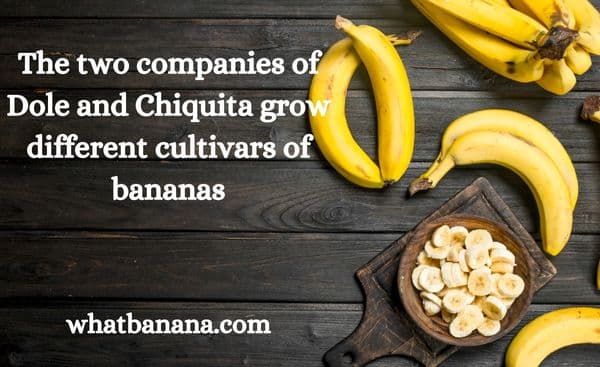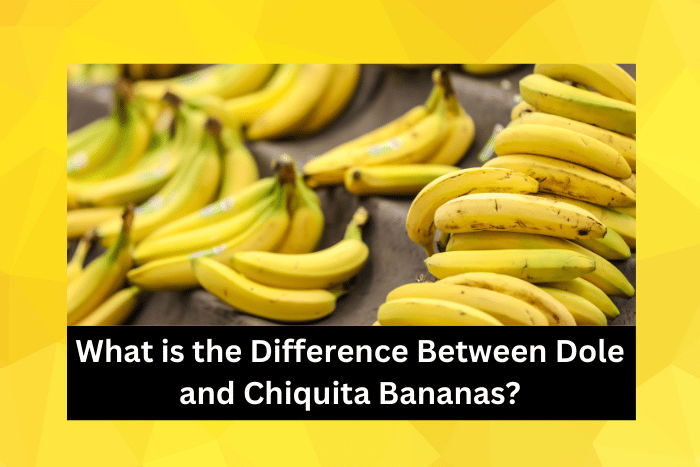Have you ever wondered what is the difference between Dole and Chiquita bananas?
After all, a banana is a banana, does it matter which company it has come from?
Maybe they are grown in different ways or in different countries.
Is either of them an organic producer?
Do they taste the same?
What other companies import bananas?
Shall we find out the truth about Dole and Chiquita? Follow me!
The two companies of Dole and Chiquita grow different cultivars of bananas. Although they both use the standard Cavendish banana, Chiquita grows the more specific Grand Nain variety. Whether they have any discernible difference in flavor is down to an individual’s taste buds. As all Cavendish bananas are genetically identical, the only difference between different brands would be in their method of storage and transport. Chiquita Brands International has recently acquired the Fyffes company, making it the biggest importer of bananas in the world.
Can You Tell the Difference Between Dole and Chiquita Bananas?
Dole and Chiquita are two of the biggest banana producers and importers in the world.
And in fact, Chiquita Brands International has recently acquired the Irish company Fyffes.
Along with Del Monte, they control 40% of the banana trade.
However, it’s unlikely that most people can even tell the difference between the two top brands of bananas.
Both producers use the standard, commercial strain of banana known as the Cavendish.
However, Chiquita grows a specific variety of it known as Grand Nain.
These are said to be slightly larger than Dole bananas
It is rumored that Chiquita has genetically modified their bananas, but there is no substantial evidence of this.
And in fact, all Cavendish bananas are genetically identical.
In effect, they are all clones.
The only factors that could make a difference to the taste are the weather and the composition of the soil.
Bananas are actually grown in over 150 countries, predominantly in Latin America.
43 million tons of bananas are sold worldwide every year.
No wonder it’s the most popular fruit in the world!

Should You Buy Fair Trade Bananas?
Although Dole and Chiquita are the two biggest brands when it comes to bananas, there are a lot of smaller producers.
Many of the smaller companies are fair trade, so should you be buying your bananas from them, rather than international conglomerates?
Let’s take a look at what fair trade actually means.
In effect, fair trade is when products are sourced directly from small-scale farmers, and they are given a fair price that covers all their costs.
At the heart of it is treating the farmers with dignity, equality, and fairness.
You may be interested to know that the very first fair-trade banana was sold in the year 2000.
Approximately one in three bananas now carry the fair-trade mark.
So, if this is your preference, you should have no difficulty in finding fair-trade bananas.
Of course, you may have to pay a little more than usual.
But the extra will go to the farmers rather than a multi-million dollar big brand company.
How Chiquita Bananas Are Grown
Final Thoughts
There is actually very little difference between Dole and Chiquita bananas.
Chiquita predominantly grows the Grand Nain variety but this has a similar taste.
The Chiquita bananas may be slightly larger.
If you prefer not to purchase big-name brands, you can consider fair trade bananas.
Then, you are assured that the farmers receive a fair price for their products.
At the end of the day, a banana is just a banana as regards the way it tastes!
But why exactly are bananas sold so cheaply?

There is a definite unmistakable difference between Dole and Chiquita Bananas beside the size element. Chiquita bananas are much much more fibrous and mealy. They also contain strong stringy elements, more so than Dole which also are more flavorful and smooth.
I did multiple tests over series of time on whole bananas and cut up bananas so I wouldn’t be swayed by banana size or label.
RIGHT ON PATRICIA, COULDN’T HAVE SAID IT BETTER MYSELF.
HUGE DIFFERENCE BETWEEN THE TWO FOR EXACTLY THE REASONS YOU STATED.
NO COMPARISON
Dole are definitely my pick of best banana! They are the banana that is the larger of the two brands and has the better flavor!
I have done the comparison. The Dole banana is definitely tastier. Chiquita had the cute commercials in the past, but the taste goes to Dole.
Smell and taste texture shape. I prefer Chiquita taste best in milk. I eat bananas and milk as breakfast.
Chiquita delmonte then dole for me
I never buy Dole for the humanitarian aspect. The Dole company went into the Philippines and since the natives had no deed to the land Dole went ahead and claimed it as their own.
The United Fruit Company, now Chiquita, under Zemurray, has done more damage than anyone else to Central American citizens and governance and economy. Of course the situation in the Philippines may have been just as bad. Buying only Fair Trade bananas (or none at all) must be preferable.
Chiquita bananas are definitely better tasting than Dole. Larger and sweeter.
There is a definite difference between Dole and Chiquita bananas. Every fiber of the Dole banana tastes like it has a wax coating. It may be intentional by design for longer storage. I never paid attention to it until my local grocer temporarily switched over to Chiquita. When I tasted them I couldn’t believe how good they were. Their texture is very smooth and they remind me of the bananas I had when I was a child. I did hear that a certain species of banana tree went extinct and I do wonder if this Grand Nain version is an offshoot from the same species.
I have both right now in my home on my counter . Chiquita was $0.39 a Lb and dole was on sale for $0.49 (usually $0.79 a Lb. I think what all these comments are doing , is mistaking brand differences when in fact they are describing different levels of ripening , room and banana temperature difference etc. right now my bananas are at 68 degrees Fahrenheit. One brand is bright yellow no spots to speak of , the other is just a tad less ripe and does have a few minor spots . Huge taste and texture difference , not because of beans but because of ripening difference .
I agree with Leon…I grew up on banana plantations on the northern coast of Honduras…its president Blake committed suicide in the 1970s when a bribe to Honduran officials to reduce the export tax per box was discovered.